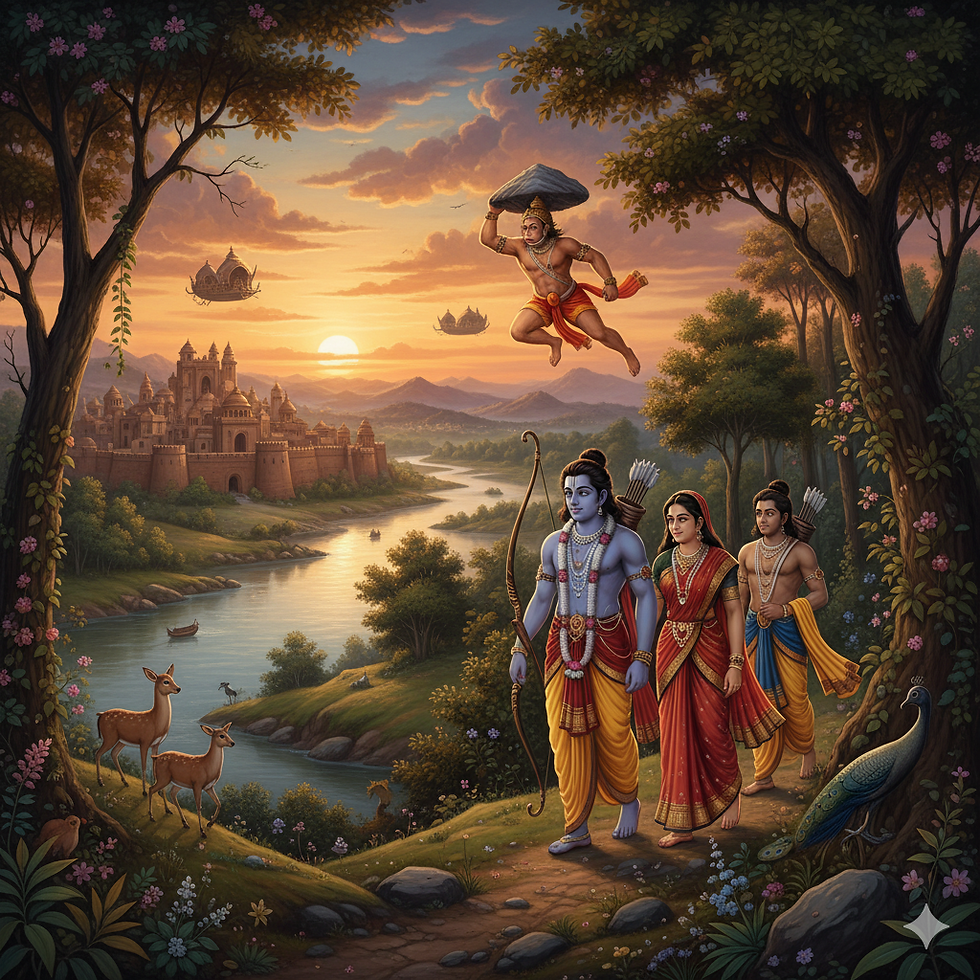What Ravana’s Ten Heads Teach Us About Right and Wrong
- myNachiketa
- Sep 26, 2025
- 3 min read

Once upon a time in ancient India, there was a powerful king named Ravana, who ruled over the beautiful island of Lanka. He was known for his wisdom and strength, as he had ten heads! Each head represented different qualities, both good and bad. While Ravana was a learned scholar and capable ruler, he also had many flaws that led to his downfall. Let’s embark on a journey to discover what these ten heads teach us about making the right choices in our lives.
myNachiketa presents What Ravana’s Ten Heads Teach Us About Right and Wrong.
The Symbol of Ten Heads
Ravana’s ten heads are often seen as symbols of his deep knowledge, but they also represent various weaknesses. Each head corresponds to a negative trait that we should avoid in our lives and choose a positive value instead. Let’s learn what each head symbolises and what we can learn from it.
Buy our books to explore more inspiring stories and lessons for children
Ego - Ravana believed he was invincible, which led him to underestimate his opponents. When we let our ego take charge, we may hurt others and make poor decisions. Instead, let’s practice humility, recognising that everyone has strengths and weaknesses.
Greed - Ravana’s desire for more power and wealth led him trouble innocent people This greed made him blind to the happiness of others. Instead, we should embrace contentment, being happy with what we have, and sharing with others.
Anger - Ravana often acted out of anger, especially in battle. This weakness made him forget his good goals. Rather than allowing anger to control us, we should cultivate patience and take time to understand situations before reacting.
Jealousy - Ravana felt jealous of what others achieved, which made him think and act wrongly. It led him to commit terrible acts, like stealing Sita Mata away from Ram. When we feel jealous, it’s essential to practice kindness and instead celebrate others’ achievements.
Disrespect - Ravana disrespected Ram and Sita, believing himself superior. This lack of respect ultimately led to his downfall. Let’s learn the value of respect, treating everyone with dignity, regardless of their status.
Selfishness - He only thought about himself and didn’t care how his actions affected others. If we practice kindness, we can help others without expecting anything back.
Dishonesty - Ravana deceived Sita and his own people, lying about his intentions. He should have shown honesty, as being truthful builds trust and respect among friends.
Manipulation - Ravana used others to get what he wanted and tricked his friends. Instead, let’s embrace loyalty, being true friends and standing by each other in every situation.
Stubbornness - Ravana refused to return Sita despite, which shows her stubbornness. This highlights the importance of flexibility, being open to changing one's mind when others present a valid perspective.
Fear – Ravana’s worry about losing what he had made him do wrong things. Instead, we should brave and act kindly, without hurting others.
The Fall of Ravana
As we learn these lessons, we see how Ravana’s commitment to his negative traits ultimately led to his downfall. On the day of victory, known as Dussehra, Rama defeated Ravana. This historic event teaches us that we can also overcome our own flaws by learning from others' mistakes.
Reflection for Children
As children, you can make choices every day that shape who you are. Recognising the values that Ravana failed to uphold can help you develop into kind, honest, and respectful individuals. Think about the last time you felt angry or jealous; how might choosing patience or kindness change your response?
Conclusion
So let’s heed the lessons of Ravana’s ten heads. Each day is an opportunity to choose the right path. You can be the heroes of your own stories, just like Rama—working together and building a world filled with respect and kindness. Remember, the power to make the right choices is within you!

More such blogs
Resources
Sources
https://www.hinduamerican.org/blog/the-symbolism-of-ravanas-10-heads/
https://www.reddit.com/r/hinduism/comments/93c7z0/what_is_the_metaphor_behind_10_heads_of_ravana/
https://www.quora.com/Ravana-had-10-heads-but-what-were-their-qualities-and-what-were-their-names
https://mythlok.com/unveiling-the-symbolic-significance-decoding-the-ten-heads-of-ravana/
https://www.bioinfo.com/2021/01/ravana-and-his-ten-heads-a-teaching-mythology/





















Comments